Petrogenesis and Metallogenesis of Late Cretaceous Adakites in the Nuri Large Cu-W-Mo Deposit, Tibet, China: Constraints from Geochronology, Geochemistry, and Hf Isotopes
Abstract
:1. Introduction
2. Geological Setting
3. Analytical Methods
4. Results
4.1. Zircon U-Pb Ages
4.2. Whole-Rock Geochemistry
4.3. Zircon Lu-Hf Isotopes
5. Discussion
5.1. Magma Source
5.2. Geodynamic Setting
5.3. Metallogenesis
6. Conclusions
Author Contributions
Funding
Data Availability Statement
Conflicts of Interest
References
- Defant, M.J.; Drummond, M.S. Derivation of some modern arc magmas by melting of young subducted lithosphere. Nature 1990, 347, 662–665. [Google Scholar] [CrossRef]
- Hou, Z.Q.; Gao, Y.F.; Qu, X.M.; Rui, Z.Y.; Mo, X.X. Origin of adakitic intrusives generated during mid-Miocene east-west extension in southern Tibet. Earth Planet. Sci. Lett. 2004, 220, 139–155. [Google Scholar] [CrossRef]
- Wang, Q.; Wyman, D.A.; Xu, J.F.; Jian, P.; Zhao, Z.H.; Li, C.F.; Xu, W.; Ma, J.L.; He, B. Early Cretaceous adakitic granites in the Northern Dabie Complex, central China: Implications for partial melting and delamination of thickened lower crust. Geochim. Cosmochim. Acta 2007, 71, 2609–2636. [Google Scholar] [CrossRef]
- Xu, J.F.; Shinjo, R.; Defant, M.J.; Wang, Q.; Rapp, R.P. Origin of Mesozoic adakitic intrusive rocks in the Ningzhen area of east China: Partial melting of delaminated lower continental crust? Geology 2002, 30, 1111–1114. [Google Scholar] [CrossRef]
- Rapp, R.P.; Shimizu, N.; Norman, M.D.; Applegate, G.S. Reaction between slab-derived melts and peridotite in the mantle wedge: Experimental constraints at 3.8 GPa. Chem. Geol. 1999, 160, 335–356. [Google Scholar] [CrossRef]
- Zhu, D.C.; Zhao, Z.D.; Pan, G.T.; Lee, H.Y.; Kang, Z.Q.; Liao, Z.L.; Wang, L.Q.; Li, G.M.; Dong, G.C.; Liu, B. Early Cretaceous subduction-related adakite-like rocks of the Gangdese Belt, southern Tibet: Products of slab melting and subsequent melt-peridotite interaction? J. Asian Earth Sci. 2009, 34, 298–309. [Google Scholar] [CrossRef]
- Hou, Z.Q.; Zheng, Y.C.; Yang, Z.M.; Rui, Z.Y.; Zhao, Z.D.; Jiang, S.H.; Qu, X.M.; Sun, Q.Z. Contribution of mantle components within juvenile lower-crust to collisional zone porphyry Cu systems in Tibet. Miner. Depos. 2013, 48, 173–192. [Google Scholar] [CrossRef]
- Zheng, Y.C.; Hou, Z.Q.; Li, Q.Y.; Sun, Q.Z.; Liang, W.; Fu, Q.; Li, W.; Huang, K.X. Origin of Late Oligocene adakitic intrusives in the southeastern Lhasa terrane: Evidence from in situ zircon U-Pb dating, Hf-O isotopes, and whole-rock geochemistry. Lithos 2012, 148, 296–311. [Google Scholar] [CrossRef]
- Zheng, Y.C.; Hou, Z.Q.; Li, W.; Liang, W.; Huang, K.X.; Sun, Q.Z.; Fu, Q.; Zhang, S. Petrogenesis and Geological Implications of the Oligocene Chongmuda-Mingze Adakite-Like Intrusions and Their Mafic Enclaves, Southern Tibet. J. Geol. 2012, 120, 647–669. [Google Scholar] [CrossRef]
- Wang, Q.; Wyman, D.A.; Xu, J.F.; Dong, Y.H.; Vasconcelos, P.M.; Pearson, N.; Wan, Y.S.; Dong, H.; Li, C.F.; Yu, Y.S.; et al. Eocene melting of subducting continental crust and early uplifting of central Tibet: Evidence from central-western Qiangtang high-K calc-alkaline andesites, dacites and rhyolites. Earth Planet. Sci. Lett. 2008, 272, 158–171. [Google Scholar] [CrossRef]
- Castillo, P.R.; Janney, P.E.; Solidum, R.U. Petrology and geochemistry of Camiguin Island, southern Philippines: Insights to the source of adakites and other lavas in a complex arc setting. Contrib. Mineral. Petrol. 1999, 134, 33–51. [Google Scholar] [CrossRef]
- Macpherson, C.G.; Dreher, S.T.; Thirlwall, M.F. Adakites without slab melting: High pressure differentiation of island arc magma, Mindanao, the Philippines. Earth Planet. Sci. Lett. 2006, 243, 581–593. [Google Scholar] [CrossRef]
- Guo, F.; Nakamuru, E.; Fan, W.M.; Kobayoshi, K.; Li, C.W. Generation of Palaeocene Adakitic Andesites by Magma Mixing; Yanji Area, NE China. J. Petrol. 2007, 48, 661–692. [Google Scholar] [CrossRef]
- Streck, M.J.; Leeman, W.P.; Chesley, J. High-magnesian andesite from Mount Shasta: A product of magma mixing and contamination, not a primitive mantle melt. Geology 2007, 35, 351–354. [Google Scholar] [CrossRef]
- Hou, Z.; Yang, Z.; Wang, R.; Zheng, Y. Further discussion on porphyry Cu-Mo-Au deposit formation in Chinese mainland. Earth Sci. Front. 2020, 27, 20–44. [Google Scholar]
- Hou, Z.; Zheng, Y.; Lu, Z.; Xu, B.; Wang, C.; Zhang, H. Growth, thickening and evolution of the thicken crust of the Tibet Plateau. Acta Geol. Sin. 2020, 94, 2797–2815. [Google Scholar]
- Wu, F.Y.; Liu, X.C.; Ji, W.Q.; Wang, J.M.; Yang, L. Highly fractionated granites: Recognition and research. Sci. China Earth Sci. 2017, 60, 1201–1219. [Google Scholar] [CrossRef]
- Pan, G.; Wang, L.; Yin, F.; Geng, Q.; Li, G.; Zhu, D. Researches on geological-tectonic evolution of Tibetan Plateau: A review recent advance, and directions in the future. Sedim. Geol. Tethyan Geol. 2022, 42, 151–175. [Google Scholar]
- Guan, Q.; Zhu, D.C.; Zhao, Z.D.; Zhang, L.L.; Liu, M.; Li, X.W.; Feng, Y.; Mo, X.X. Late Cretaceous Adakites in the Eastern Segment of the Gangdese Belt, Southern Tibet: Products of Neo-Tethyan Ridge Subduction? Acta Petrol. Sin. 2010, 26, 2165–2179. [Google Scholar]
- Wang, X.H.; Lang, X.H.; Tang, J.X.; Deng, Y.L.; Cui, Z.W. Early-Middle Jurassic (182–170 Ma) Ruocuo adakitic porphyries, southern margin of the Lhasa terrane, Tibet: Implications for geodynamic setting and porphyry Cu-Au mineralization. J. Asian Earth Sci. 2019, 173, 336–351. [Google Scholar] [CrossRef]
- Lang, X.H.; Tang, J.X.; Li, Z.J.; Huang, Y.; Ding, F.; Yang, H.H. U-Pb and Re-Os geochronological evidence for the Jurassic porphyry metallogenic event of the Xiongcun district in the Gangdese porphyry copper belt, southern Tibet, PRC. J. Asian Earth Sci. 2014, 79, 608–622. [Google Scholar] [CrossRef]
- Wang, Y.Y.; Tang, J.X.; Zheng, W.B.; Duan, J.L.; Song, J.L.; Yang, C. Mechanism of metal precipitation in Dabu porphyry Cu-Mo deposit, Quxu Country, Tibet. Miner. Deposit. 2015, 31, 81–97. [Google Scholar]
- Wen, D.R.; Chung, S.L.; Song, B.; Iizuka, Y.; Yang, H.J.; Ji, J.Q.; Liu, D.Y.; Gallet, S. Late Cretaceous Gangdese intrusions of adakitic geochemical characteristics, SE Tibet: Petrogenesis and tectonic implications. Lithos 2008, 105, 1–11. [Google Scholar] [CrossRef]
- Zhu, D.C.; Wang, Q.; Cawood, P.A.; Zhao, Z.D.; Mo, X.X. Raising the Gangdese Mountains in southern Tibet. J. Geophys. Res. Solid Earth 2017, 122, 214–223. [Google Scholar] [CrossRef]
- Zheng, Y.C.; Hou, Z.Q.; Gong, Y.L.; Liang, W.; Sun, Q.Z.; Zhang, S.; Fu, Q.; Huang, K.X.; Li, Q.Y.; Li, W. Petrogenesis of Cretaceous adakite-like intrusions of the Gangdese Plutonic Belt, southern Tibet: Implications for mid-ocean ridge subduction and crustal growth. Lithos 2014, 190–191, 240–263. [Google Scholar] [CrossRef]
- Ma, L.; Wang, Q.; Li, Z.X.; Wyman, D.A.; Yang, J.H.; Jiang, Z.Q.; Liu, Y.S.; Gou, G.N.; Guo, H.F. Subduction of Indian continent beneath southern Tibet in the latest Eocene (~35Ma): Insights from the Quguosha gabbros in southern Lhasa block. Gondwana Res. 2017, 41, 77–92. [Google Scholar] [CrossRef]
- Xu, W.C.; Zhang, H.F.; Luo, B.J.; Guo, L.; Yang, H. Adakite-like geochemical signature produced by amphibole-dominated fractionation of arc magmas: An example from the Late Cretaceous magmatism in Gangdese belt, south Tibet. Lithos 2015, 232, 197–210. [Google Scholar] [CrossRef]
- Zhang, Z.M.; Zhao, G.C.; Santosh, M.; Wang, J.L.; Dong, X.; Shen, K. Late Cretaceous charnockite with adakitic affinities from the Gangdese batholith, southeastern Tibet: Evidence for Neo-Tethyan mid-ocean ridge subduction? Gondwana Res. 2010, 17, 615–631. [Google Scholar] [CrossRef]
- Wen, D.R.; Liu, D.Y.; Chung, S.L.; Chu, M.F.; Li, J.Q.; Zhang, Q.; Song, B.; Lee, T.Y.; Yeh, M.W.; Lo, C.H. Zircon SHRIMP U-Pb ages of the Gangdese Batholith and implications for Neotethyan subduction in southern Tibet. Chem. Geol. 2008, 252, 191–201. [Google Scholar] [CrossRef]
- Ma, L.; Wang, Q.; Li, Z.X.; Wyman, D.A.; Jiang, Z.Q.; Yang, J.H.; Gou, G.L.; Guo, H.G. Early Late Cretaceous (ca. 93 Ma) norites and hornblendites in the Milin area, eastern Gangdese: Lithosphere-asthenosphere interaction during slab roll-back and an insight into early Late Cretaceous (ca. 100–80 Ma) magmatic “flare-up” in southern Lhasa (Tibet). Lithos 2013, 172–173, 17–30. [Google Scholar]
- Ma, L.; Wang, Q.; Wyman, D.A.; Jiang, Z.Q.; Yang, J.H.; Li, Q.L.; Gou, G.N.; Guo, H.F. Late Cretaceous crustal growth in the Gangdese area, southern Tibet: Petrological and Sr-Nd-Hf-O isotopic evidence from Zhengga diorite-gabbro. Chem. Geol. 2013, 349–350, 54–70. [Google Scholar] [CrossRef]
- Ma, L.; Wang, Q.; Wyman, D.A.; Li, Z.X.; Jiang, Z.Q.; Yang, J.H.; Gou, G.L.; Guo, H.F. Late Cretaceous (100–89Ma) magnesian charnockites with adakitic affinities in the Milin area, eastern Gangdese: Partial melting of subducted oceanic crust and implications for crustal growth in southern Tibet. Lithos 2013, 175–176, 315–332. [Google Scholar] [CrossRef]
- Guo, L.; Zhang, H.F.; Harris, N.; Pan, F.B.; Xu, C.W. Late Cretaceous (81 Ma) high-temperature metamorphism in the southeastern Lhasa terrane: Implication for the Neo-Tethys ocean ridge subduction. Tectonophysics 2013, 608, 112–126. [Google Scholar] [CrossRef]
- Chen, L.; Qin, K.Z.; Li, G.M.; Li, J.X.; Xiao, B.; Zhao, J.X.; Fan, X. Zircon U-Pb ages, geochemistry, and Sr-Nd-Pb-Hf isotopes of the Nuri intrusive rocks in the Gangdese area, southern Tibet: Constraints on timing, petrogenesis, and tectonic transformation. Lithos 2015, 212–215, 379–396. [Google Scholar] [CrossRef]
- Yang, Z.M.; Hou, Z.Q.; White, N.C.; Chang, Z.S.; Li, Z.Q.; Song, Y.C. Geology of the post-collisional porphyry copper-molybdenum deposit at Qulong, Tibet. Ore Geol. Rev. 2009, 36, 133–159. [Google Scholar] [CrossRef]
- Yang, Z.M.; Goldfarb, R.; Chang, Z.S. Generation of postcollisional porphyry copper deposits in southern Tibet triggered by subduction of the Indian continental plate. Soc. Econ. Geol. Spec. Publ. 2016, 19, 279–300. [Google Scholar]
- Yang, Z.M.; Hou, Z.Q.; Chang, Z.S.; Li, Q.Y.; Liu, Y.F.; Qu, H.C.; Sun, M.Y.; Xu, B. Cospatial Eocene and Miocene granitoids from the Jiru Cu deposit in Tibet: Petrogenesis and implications for the formation of collisional and postcollisional porphyry Cu systems in continental collision zones. Lithos 2016, 245, 243–257. [Google Scholar] [CrossRef]
- Yin, Q.; Lang, X.; Cui, Z.; Xie, F.W.; Wang, X.H. Geology and geochemistry constraints on the genesis of the no. 2 porphyry copper-gold deposit in the Xiongcun District, gangdese porphyry copper belt, Tibet, China. Appl. Ecol. Environ. Res. 2017, 15, 477–508. [Google Scholar] [CrossRef]
- Chu, M.F.; Chung, S.L.; Song, B.; Liu, D.; O’Reilly, S.Y.; Person, N.J.; Wen, D.J. Zircon U-Pb and Hf isotope constraints on the Mesozoic tectonics and crustal evolution of southern Tibet. Geology 2006, 34, 745–748. [Google Scholar] [CrossRef]
- Ji, W.Q.; Wu, F.Y.; Chung, S.L.; Li, J.X.; Liu, C.Z. Zircon U-Pb geochronology and Hf isotopic constraints on petrogenesis of the Gangdese batholith, southern Tibet. Chem. Geol. 2009, 262, 229–245. [Google Scholar] [CrossRef]
- Zhu, D.C.; Wang, Q.; Chung, S.L.; Peter, A.C.; Zhao, Z.D. Gangdese magmatism in southern Tibet and India–Asia convergence since 120 Ma. Geol. Soc. Spec. Publ. 2019, 483, 583–604. [Google Scholar] [CrossRef]
- Tang, J.X.; Lang, X.H.; Xie, F.W.; Gao, Y.M.; Li, Z.J.; Huang, Y.; Ding, F.; Yang, H.H.; Zhang, L.; Wang, Q.; et al. Geological characteristics and genesis of the Jurassic No. I porphyry Cu-Au deposit in the Xiongcun district, Gangdese porphyry copper belt, Tibet. Ore Geol. Rev. 2015, 70, 438–456. [Google Scholar] [CrossRef]
- Cheng, Y.Q.; Chen, Y.C.; Zhao, Y.M. Preliminary discussion on the problems of minerogenetic series of mineral deposits. J. Chin. Acad. Geol. Sci. 1979, 1, 32–58. [Google Scholar]
- Chen, Y.C. Metallogenic series of ore deposits. Earth Sci. Front. (China Univ. Geosci. Beijing) 1994, 1, 90–94. [Google Scholar]
- Chen, Y.C.; Pei, R.F.; Wang, D.H.; Huang, F. Four-dimensional metallogeny in earth system and study trends of mineral deposits: A discussion on minerogenetic series (VII). Miner. Depos. 2020, 39, 745–753. [Google Scholar]
- Chen, Y.C.; Pei, R.F.; Wang, D.H.; Huang, F. A discussion on minerogenetic series of mineral deposits. Acta Geol. Sin. 2022, 96, 123–130. [Google Scholar]
- Tang, J.X.; Wang, L.Q.; Yang, H.H.; Gao, X.; Zhang, Z.B.; Zou, B. Mineralization, exploration and resource potential of porphyry–skarn–epithermal copper polymetallic deposits in Tibet. Acta Geosci. Sin. 2017, 38, 571–613. [Google Scholar]
- Tang, J.X.; Yang, H.H.; Song, Y.; Wang, L.Q.; Liu, Z.B.; Li, B.L.; Peng, B.; Wang, G.H.; Zeng, Q.G.; Wang, Q.; et al. The copper polymetallic deposits and resource potential in the Tibet Plateau. China Geol. 2021, 401, 1–16. [Google Scholar] [CrossRef]
- Wang, Q.; Huang, Y.; Dong, S.L.; Yan, G.Q.; You, Q.; Jiang, H.Z.; Zhang, K. Zircon LA-ICPMS U-Pb Geochronology, Geochemistry and Implications of Ore-Forming Porphyry in NURI Skarn Cu-Mo-W Deposit, Eastern Gangdise. Miner. Depos. 2018, 37, 571–586. [Google Scholar]
- Wang, Y.Y.; Zheng, W.B.; Chen, Y.C.; Tang, J.X.; Leng, Q.F.; Tang, P.; Ding, S.; Zhou, Y. Descussion on the mechanism of seperation of copper and molybdenum in Jima porphyry deposit system, Tibet. Acta Petrol. Sin. 2017, 33, 495–514. [Google Scholar]
- Zheng, Y.Y.; Wu, S.; Ci, Q.; Chen, X.; Gao, S.B.; Liu, X.F.; Jiang, X.W.; Zheng, S.L.; Li, M.; Jiang, X.J. Cu-Mo-Au Metallogenesis and Minerogenetic Series during superimposed orogenesis process in Gangdese. Earth Sci. 2021, 46, 1909–1940. [Google Scholar]
- Xie, F.W.; Lang, X.H.; Tang, J.X.; He, Q.; Deng, Y.L.; Wang, X.H.; Wang, Y.; Jia, M. Metallogenic regularity of Gangdese Metallogenic Belt, Tibet. Miner. Deposit. 2022, 41, 952–974. [Google Scholar]
- Lin, B.; Tang, J.X.; Tang, P.; Beaudoin, G.; Laflamme, C.; Li, F.; Zheng, W.B.; Song, Y.; Qi, J.; Sun, M.; et al. Multipulsed Magmatism and Duration of the Hydrothermal System of the Giant Jiama porphyry Cu system, Tibet, China. Econ. Geol. 2024, 119, 201–217. [Google Scholar] [CrossRef]
- Pan, G.T.; Ding, J.; Yao, D.S.; Wang, L.Q. Guidebook of 1:1,500,000 Geologic Map of the Qinghai–Xizang (Tibet) Plateau and Adjacent Areas; Chengdu Cartographic Publishing House: Chengdu, China, 2004; 148p. [Google Scholar]
- Tang, J.X.; Wang, L.Q.; Ci, Q.; Zhong, K.H.; Zhang, H.P.; Du, X.; Ze, R.Z.X.; Yan, J.; Ma, G.T.; Song, Y. Minerogenetic Series of Ore Deposits in the East Part of the Gangdese Metallogenic Belt; Geological Publishing House: Beijing, China, 2020; 226p. [Google Scholar]
- Wang, D.H.; Chen, Y.C.; Xu, Z.G.; Huang, F.; Wang, Y.; Pei, R.F. Minerogenetic series group: Discussion on minerogenetic series (VI). Acta Geol. Sin. 2020, 94, 18–35. [Google Scholar]
- Liang, H.Y.; Wei, Q.R.; Xu, J.F.; Hu, G.Q.; Allen, C.M. Study on Zircon LA-ICP-MS U-Pb age of skarn Cu mineralization related intrusion in the southern margin of the Gangdese ore belt, Tibet and its geological implication. Acta Petrol. Sin. 2010, 26, 1692–1698. [Google Scholar]
- Dai, Z.W.; Li, G.M.; Ding, J.; Huang, Y.; Cao, H.W. Late Cretaceous Adakite in Nuri Area, Tibet: Products of Ridge Subduction. Earth Sci. 2018, 43, 2727–2741. [Google Scholar]
- Chen, L.; Qin, K.Z.; Li, G.M.; Li, J.X.; Xiao, B.; Zhao, J.X. In situ major and trace elements of garnet and scheelite in the Nuri Cu–W–Mo deposit, South Gangdese, Tibet: Implications for mineral genesis and ore-forming fluid records. Ore Geol. Rev. 2020, 122, 103549. [Google Scholar] [CrossRef]
- Zhang, S. The Metallogenesis of Nuri Skarn Cu-W-Mo Deposit in Southern Gangdese, Tibet. Master’s Thesis, China University of Geosciences (Beijing), Beijing, China, 2012; 138p. [Google Scholar]
- Yan, G.Q.; Wang, X.X.; Huang, Y.; Liu, H.; Huang, H.X.; Tian, E.Y.; Lai, Y.; Zhao, J. Evolution characteristics of Magma in the Nuri superlarge polymetallic deposit, Tibet: Implications for regional mineralization in the Shannan ore cluster area. Acta Geol. Sin. 2018, 92, 2138–2154. [Google Scholar]
- Hu, Z.; Li, X.H.; Luo, T.; Zhang, W.; Crowley, J.; Li, Q.L.; Ling, X.X.; Yang, C.; Li, Y.; Feng, L.P.; et al. Tanz zircon megacrysts: A new zircon reference material for the microbeam determination of U–Pb ages and Zr–O isotopes. J. Anal. At. Spectrom. 2021, 36, 2715–2734. [Google Scholar] [CrossRef]
- Sláma, J.; Košler, J.; Condon, D.J.; Gerdes, J.L.; Hanchar, A.; Horstwood, J.M.; Morris, G.A.; Norberg, L.; Nasdala, L.; Norberg, N.; et al. Plešovice zircon—A new natural reference material for U–Pb and Hf isotopic microanalysis. Chem. Geol. 2008, 249, 1–35. [Google Scholar] [CrossRef]
- Chu, G.B.; Chen, H.Y.; Falloon, T.J.; Han, J.S.; Zhang, S.T.; Cheng, J.M.; Zhang, X.B. Early Cretaceous mantle upwelling and melting of juvenile lower crust in the Middle-Lower Yangtze River Metallogenic Belt: Example from Tongshankou Cu-(Mo-W) ore deposit. Gondwana Res. 2020, 83, 183–200. [Google Scholar] [CrossRef]
- Blichert-Toft, J.; Francis Albarède. The Lu-Hf isotope geochemistry of chondrites and the evolution of the mantle-crust system. Earth Planet. Sci. Lett. 1997, 148, 243–258. [Google Scholar] [CrossRef]
- Griffin, W.L.; Pearson, N.J.; Belousova, E.; Jackson, S.E.; Achterbergh, E.; O’Reilly, S.Y.; Shee, S.R. The Hf isotope composition of cratonic mantle: LAM-MC-ICPMS analysis of zircon megacrysts in kimberlites. Geochim. Cosmochim. Acta 2000, 64, 133–147. [Google Scholar] [CrossRef]
- Söderlund, U.; Patchett, P.J.; Vervoort, J.D.; Isachsen, C.E. The 176Lu decay constant determined by Lu-Hf and U-Pb isotope systematics of Precambrian mafic intrusions. Earth Planet. Sci. Lett. 2004, 219, 311–324. [Google Scholar] [CrossRef]
- Griffin, W.L.; Wang, X.; Jackson, S.E.; Pearson, N.J.; O’Reilly, S.Y.; Xu, X.S.; Zhou, X.M. Zircon chemistry and magma mixing, SE China: In-situ analysis of Hf isotopes, Tonglu and Pingtan igneous complexes. Lithos 2002, 61, 237–269. [Google Scholar] [CrossRef]
- Wu, Y.B.; Zheng, Y.F. Zircon genetic mineralogy and its constrain for interpretation of U-Pb age. Chin. Sci. Bull. 2004, 49, 1589–1604. [Google Scholar] [CrossRef]
- Peccerillo, A.; Taylor, S.R. Geochemistry of eocene calc-alkaline volcanic rocks from the Kastamonu area, Northern Turkey. Contrib. Mineral. Petrol. 1976, 58, 63–81. [Google Scholar] [CrossRef]
- Maniar, P.D.; Piccoli, P.M. Tectonic Discrimation of Granitiods. Geol. Soc. Am. Bull. 1989, 101, 635–643. [Google Scholar] [CrossRef]
- Zhao, Z.; Hu, D.G.; Lu, L.; Wu, Z.H. Discovery and metallogenic significance of the Late Cretacous Adakites from Zedang, Tibet. J. Geomech. 2013, 19, 45–52. [Google Scholar]
- Wu, C.D.; Zheng, Y.C.; Xu, B.; Hou, Z.Q. The genetic relationship between JTA–like magmas and typical adakites: An example from the Late Cretaceous Nuri complex, southern Tibet. Lithos 2018, 320, 265–279. [Google Scholar] [CrossRef]
- Sun, S.S.; Mcdonough, W.F. Chemical and isotopic systematics of oceanic basalts: Implications for mantle composition and processes. In Magmatism in the ocean basins. Geol. Soc. Spec. Publ. 1989, 42, 313–345. [Google Scholar] [CrossRef]
- Martin, H.; Smithies, R.H.; Rapp, R.; Moyen, J.F.; Champion, D. An overview of adakite, tonalite-trondhjemite-granodiorite (TTG), and sanukitoid: Relationships and some implications for crustal evolution. Lithos 2005, 79, 1–24. [Google Scholar] [CrossRef]
- Wu, F.Y.; Li, X.H.; Zheng, Y.F.; Gao, S. Lu-Hf Isotopic Systematics and Their Applications in Petrology. Acta Petrol. Sin. 2007, 23, 185–220. [Google Scholar]
- Sen, C.; Dun, T. Dehydration melting of a basaltic composition amphibolite at 1.5 and 2.0 Gpa: Implications for the origin of adakites. Contrib. Mineral. Petrol. 1994, 117, 394–409. [Google Scholar] [CrossRef]
- Rapp, R.P.; Watson, E.B. Dehydration Melting of Metabasalt at 8–32 kbar: Implications for Continental Growth and Crust-Mantle Recycling. J. Petrol. 1995, 36, 891–931. [Google Scholar] [CrossRef]
- Liu, S.A.; Li, S.G.; He, Y.S.; Huang, F. Geochemical contrasts between early Cretaceous ore-bearing and ore-barren high-Mg adakites in central-eastern China: Implications for petrogenesis and Cu–Au mineralization. Geochim. Cosmochim. Acta. 2010, 74, 7160–7178. [Google Scholar] [CrossRef]
- Iwamori, H. Thermal effects of ridge subduction and its implications for the origin of granitic batholith and paired metamorphic belts. Earth Planet. Sci. Lett. 2000, 181, 131–144. [Google Scholar] [CrossRef]
- Jiang, H.Z.; Zeng, H.L.; Wu, Z.S. Geological Characteristics and Prospecting Prediction in Deep Area of Layer Skarn Cu-W-Mo Deposit in Shannan Nuri Ore District, Tibet. Geol. Prospect. 2011, 47, 71–77. [Google Scholar]
- Zhou, A. Thermochronological Constrains on the Exhumation History of Porphyry-Type Deposit in Gangdese Metallogenic Belt, Tibet. Ph.D. Thesis, University of Geosciences (Beijing), Beijing, China, 2017; 164p. [Google Scholar]
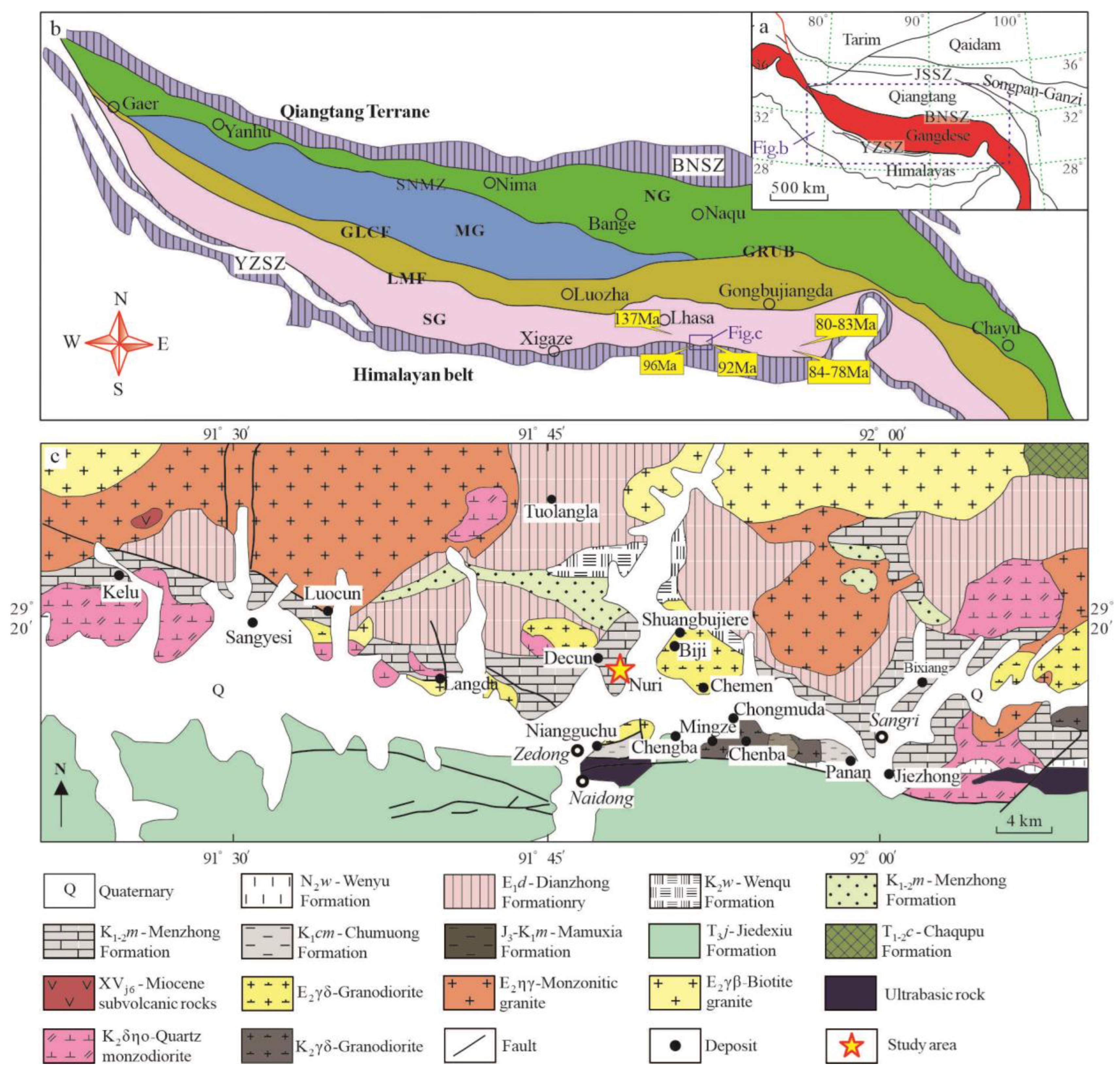
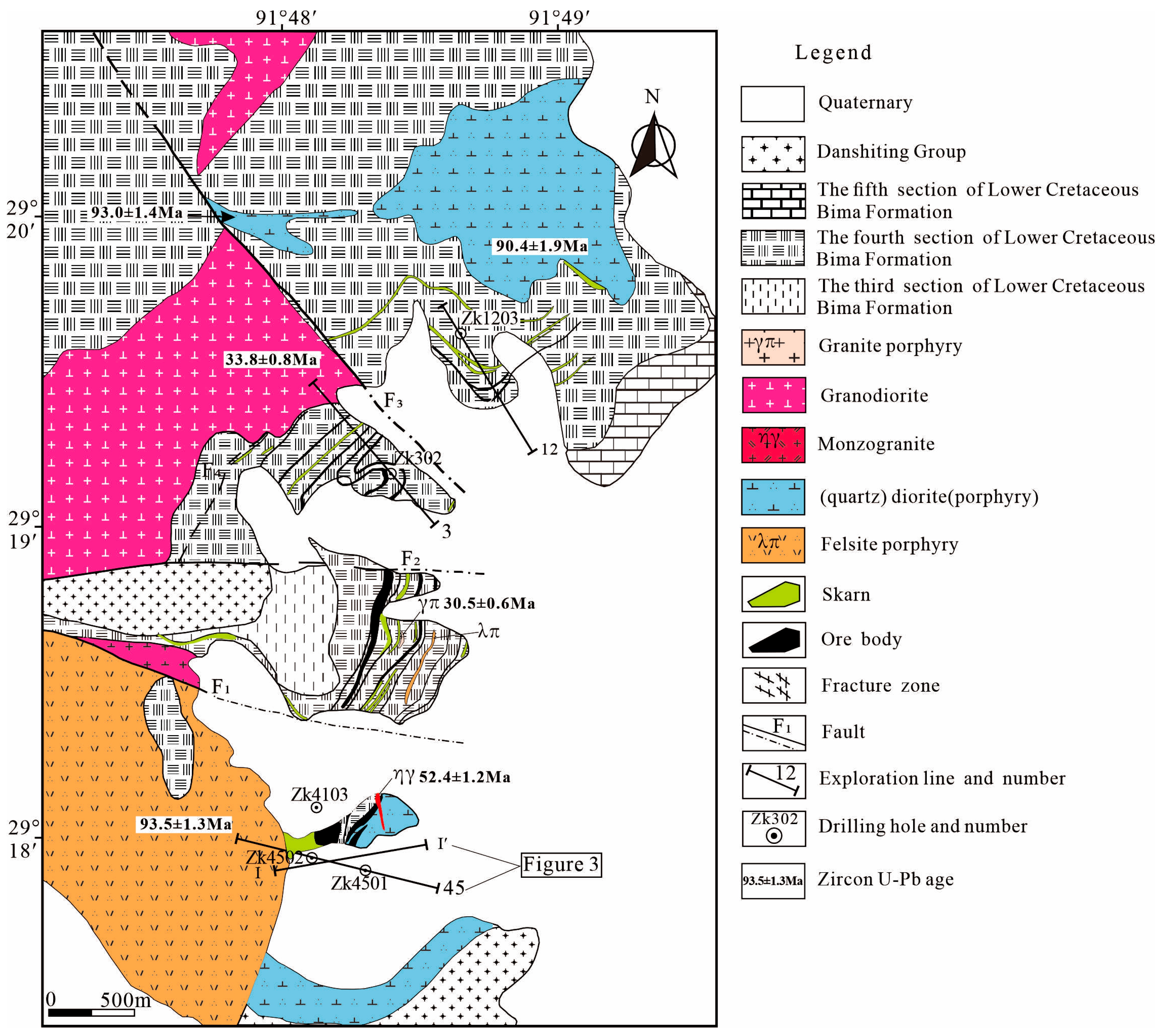
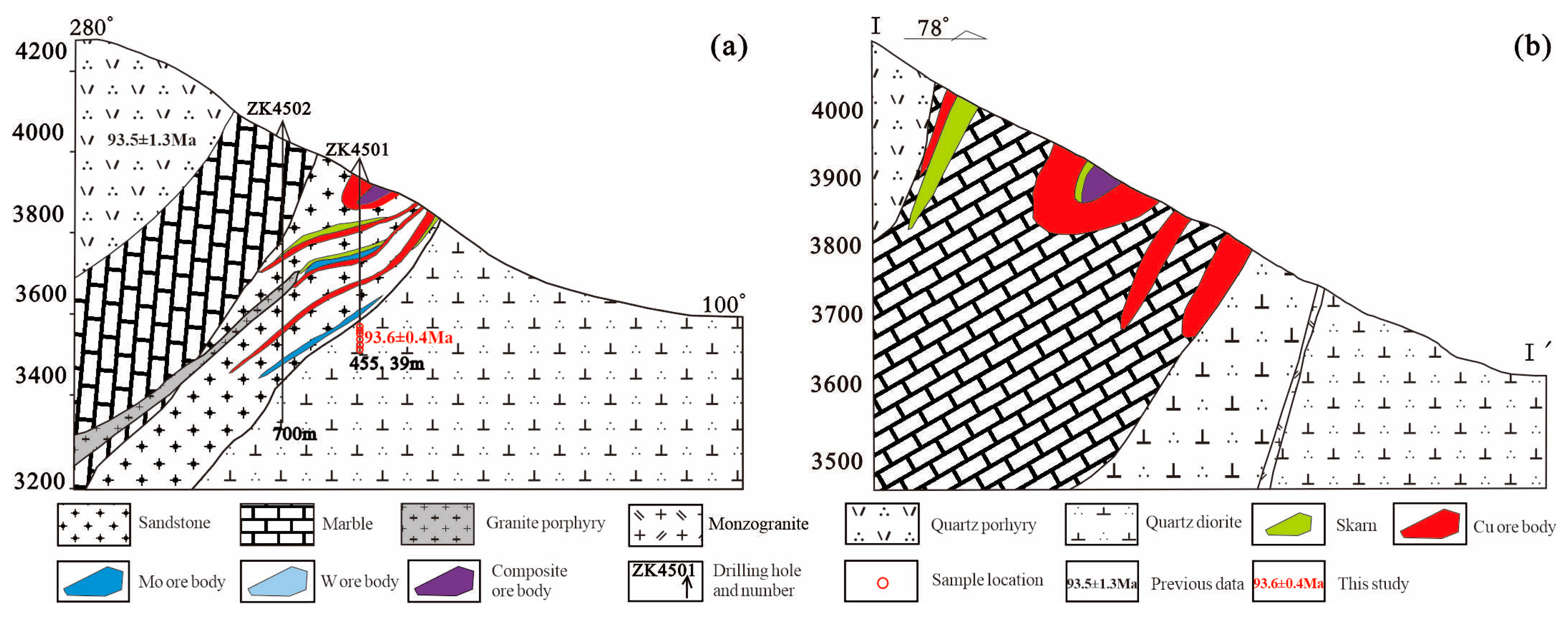
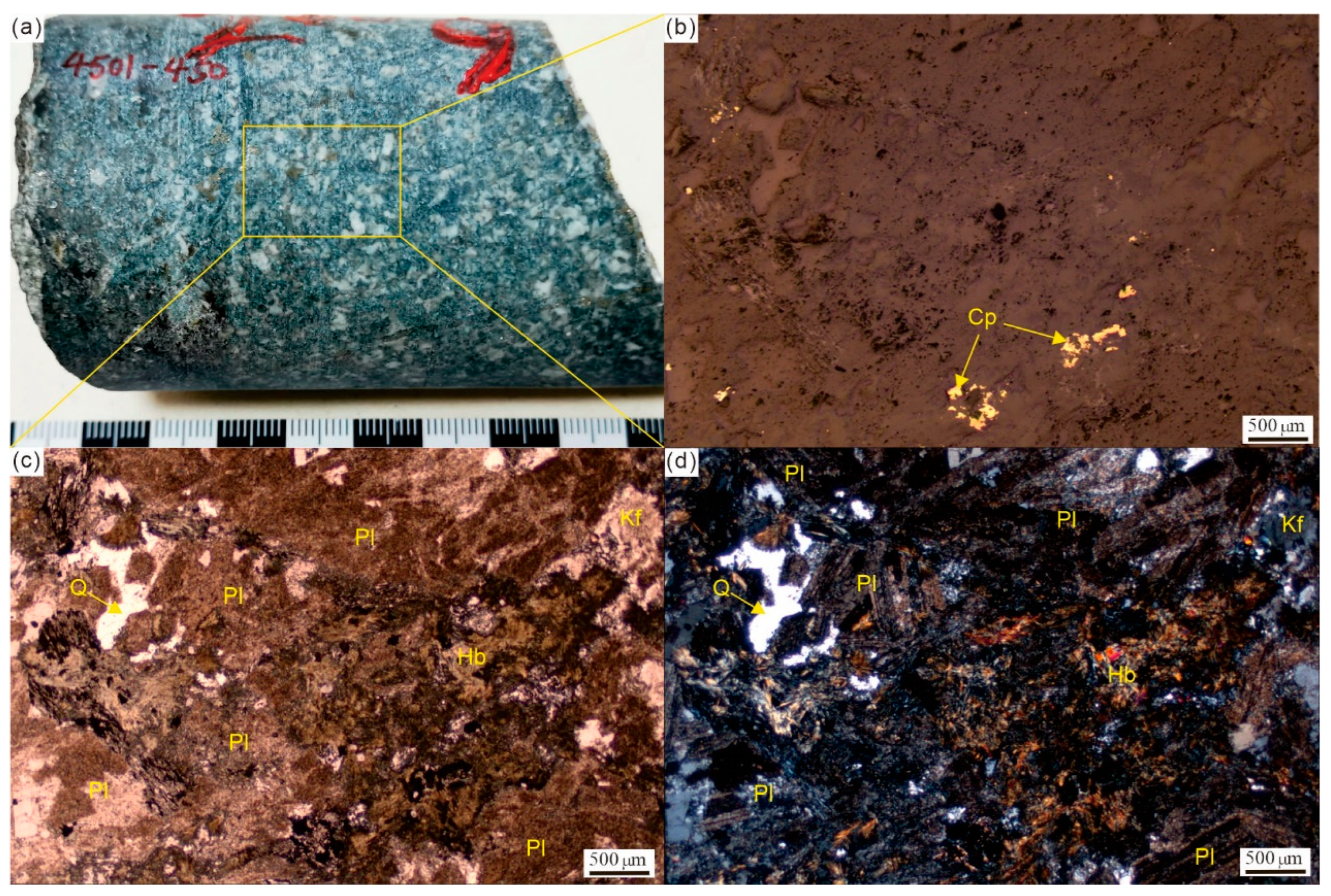




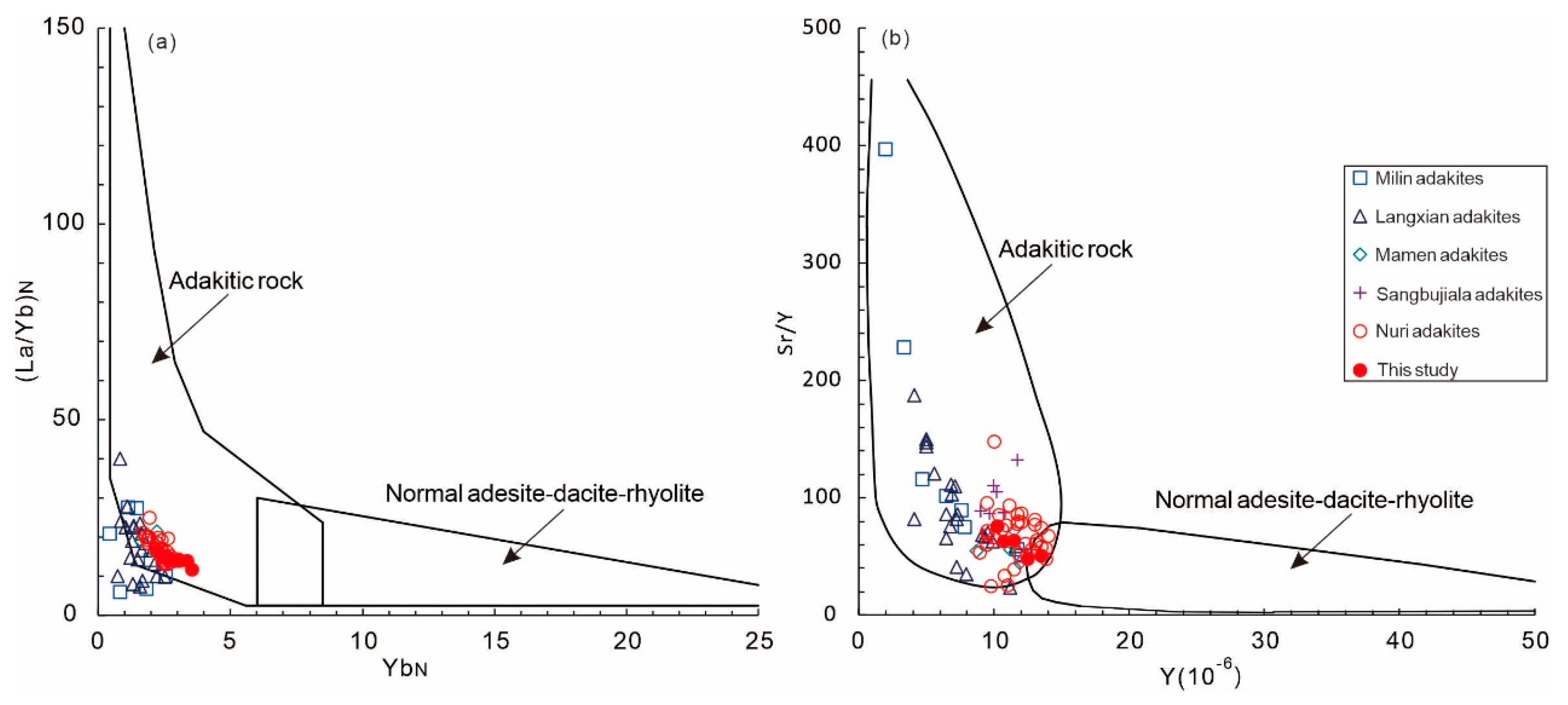

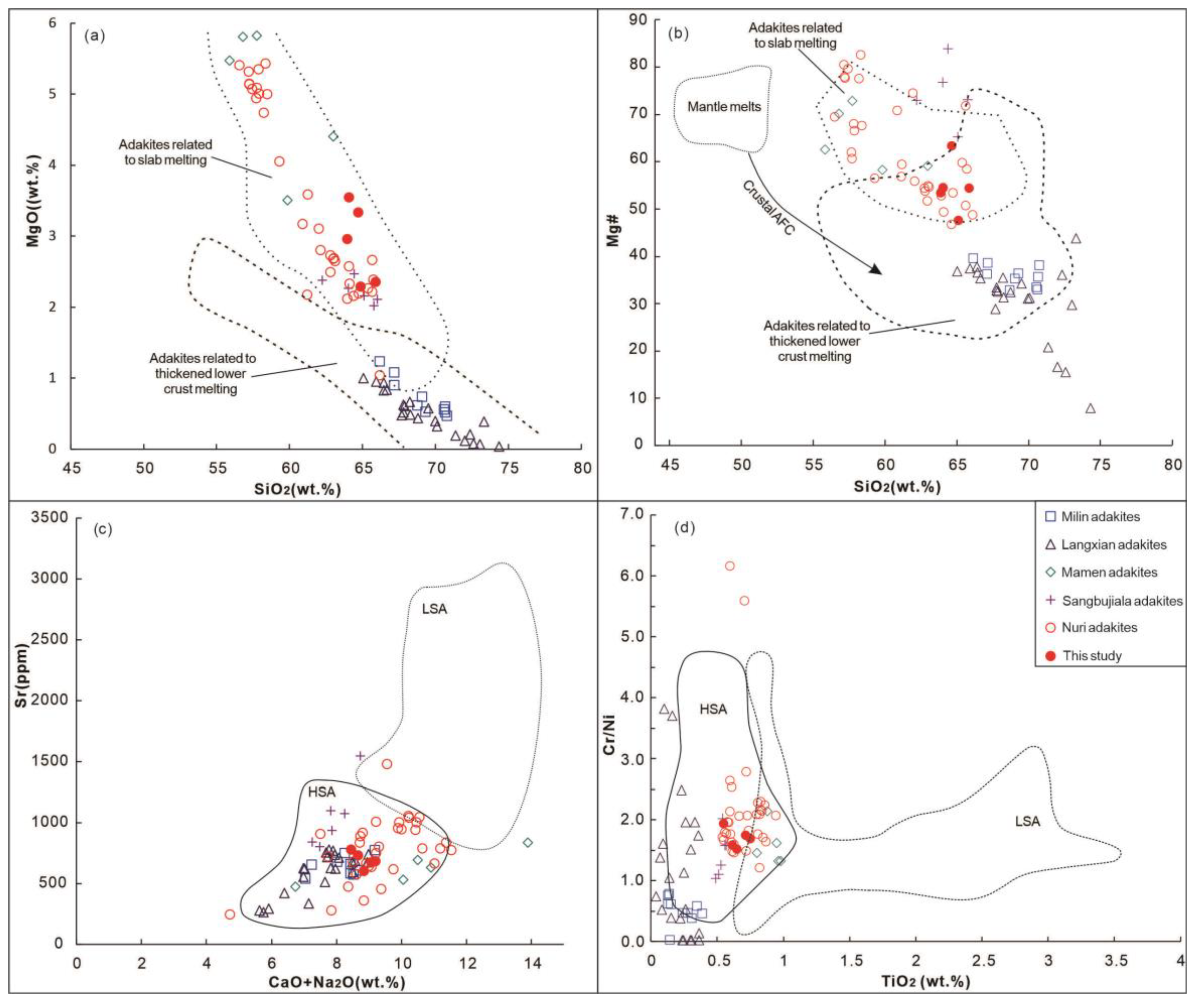

| No. | Pb (ppm) | Th (ppm) | U (ppm) | Th/U | 207Pb/206Pb | 1s% | 207Pb/235U | 1s% | 206Pb/238U | 1s% | 207Pb/235U | 2s (abs) | 206Pb/238U | 2s (abs) |
|---|---|---|---|---|---|---|---|---|---|---|---|---|---|---|
| 1 | 2.1 | 339.9 | 310.8 | 1.1 | 0.0495 | 4.89 | 0.0977 | 4.65 | 0.0143 | 1.04 | 94.2 | 8.4 | 91.6 | 1.9 |
| 2 | 3.5 | 766.0 | 511.1 | 1.5 | 0.0469 | 4.22 | 0.0962 | 4.19 | 0.0148 | 0.86 | 92.9 | 7.4 | 94.6 | 1.6 |
| 3 | 2.9 | 590.4 | 418.4 | 1.4 | 0.0503 | 4.13 | 0.1023 | 4.19 | 0.0147 | 1.08 | 98.6 | 7.9 | 93.8 | 2.0 |
| 4 | 1.0 | 151.9 | 156.0 | 1.0 | 0.0435 | 7.52 | 0.0867 | 7.24 | 0.0144 | 1.77 | 86.4 | 12.8 | 92.4 | 3.3 |
| 5 | 1.6 | 249.4 | 237.8 | 1.0 | 0.0507 | 6.95 | 0.1050 | 6.54 | 0.0150 | 1.37 | 100.5 | 12.7 | 96.0 | 2.6 |
| 6 | 2.9 | 612.8 | 416.5 | 1.5 | 0.0508 | 4.46 | 0.1031 | 4.26 | 0.0147 | 1.11 | 99.3 | 8.1 | 94.3 | 2.1 |
| 7 | 3.5 | 1058.6 | 523.4 | 2.0 | 0.0440 | 4.79 | 0.0892 | 4.88 | 0.0145 | 1.08 | 86.4 | 8.2 | 93.0 | 2.0 |
| 8 | 0.9 | 168.4 | 140.3 | 1.2 | 0.0534 | 7.71 | 0.1038 | 6.87 | 0.0142 | 1.92 | 99.3 | 13.0 | 91.1 | 3.5 |
| 9 | 3.1 | 446.6 | 456.4 | 1.0 | 0.0457 | 3.99 | 0.0918 | 3.97 | 0.0145 | 1.13 | 88.9 | 6.8 | 92.8 | 2.1 |
| 10 | 3.4 | 683.0 | 503.0 | 1.4 | 0.0453 | 5.63 | 0.0904 | 5.54 | 0.0144 | 1.10 | 87.5 | 9.3 | 92.0 | 2.0 |
| 11 | 2.3 | 218.4 | 340.6 | 0.6 | 0.0454 | 5.61 | 0.0919 | 5.52 | 0.0146 | 1.10 | 88.8 | 9.4 | 93.6 | 2.0 |
| 12 | 1.1 | 123.5 | 162.7 | 0.8 | 0.0441 | 8.07 | 0.0870 | 7.87 | 0.0144 | 1.82 | 83.8 | 12.8 | 92.2 | 3.3 |
| 13 | 0.8 | 109.0 | 115.3 | 0.9 | 0.0427 | 9.00 | 0.0856 | 8.67 | 0.0141 | 1.78 | 82.3 | 13.7 | 90.2 | 3.2 |
| 14 | 1.5 | 168.3 | 214.9 | 0.8 | 0.0482 | 6.12 | 0.1000 | 5.93 | 0.0151 | 1.32 | 96.1 | 10.9 | 96.5 | 2.5 |
| 15 | 1.4 | 165.4 | 215.1 | 0.8 | 0.0467 | 8.19 | 0.0897 | 7.54 | 0.0145 | 1.42 | 86.3 | 12.4 | 92.7 | 2.6 |
| 16 | 4.4 | 885.5 | 653.5 | 1.4 | 0.0507 | 3.71 | 0.1033 | 3.62 | 0.0147 | 0.84 | 99.56 | 6.9 | 94.1 | 1.6 |
| 17 | 2.0 | 213.1 | 301.2 | 0.7 | 0.0463 | 5.56 | 0.0927 | 5.62 | 0.0145 | 1.08 | 89.5 | 9.6 | 92.7 | 2.0 |
| 18 | 2.0 | 233.3 | 285.4 | 0.8 | 0.0467 | 5.63 | 0.0969 | 5.41 | 0.0151 | 1.12 | 93.4 | 9.7 | 96.6 | 2.2 |
| 19 | 1.4 | 209.2 | 209.1 | 1.0 | 0.0484 | 6.97 | 0.0984 | 6.62 | 0.0148 | 1.34 | 94.5 | 12.0 | 94.8 | 2.5 |
| 20 | 3.0 | 346.5 | 458.3 | 0.8 | 0.0458 | 4.99 | 0.0911 | 4.82 | 0.0145 | 1.19 | 88.15 | 8.2 | 92.6 | 2.2 |
| 21 | 2.6 | 326.5 | 373.3 | 0.9 | 0.0448 | 4.41 | 0.0934 | 4.47 | 0.0151 | 1.24 | 90.3 | 7.7 | 96.4 | 2.4 |
| 22 | 3.1 | 286.9 | 454.6 | 0.6 | 0.0490 | 3.80 | 0.1001 | 3.89 | 0.0148 | 1.14 | 96.6 | 7.2 | 94.4 | 2.1 |
| 23 | 4.5 | 958.2 | 676.2 | 1.4 | 0.0474 | 3.93 | 0.0952 | 3.90 | 0.0145 | 0.72 | 92.1 | 6.7 | 92.7 | 1.3 |
| Sample | 4501–450.3 | 4501–451.7 | 4501–452.4 | 4501–453.6 | 4501–454.8 |
|---|---|---|---|---|---|
| major element (wt.%) | |||||
| SiO2 | 64.70 | 63.94 | 64.07 | 65.91 | 64.88 |
| TiO2 | 0.72 | 0.65 | 0.75 | 0.55 | 0.61 |
| Al2O3 | 15.54 | 15.33 | 14.14 | 14.71 | 15.03 |
| TFe2O3 | 3.86 | 5.17 | 5.91 | 3.94 | 5.33 |
| MnO | 0.07 | 0.07 | 0.09 | 0.06 | 0.05 |
| MgO | 3.33 | 2.96 | 3.55 | 2.35 | 2.29 |
| CaO | 5.39 | 5.45 | 5.35 | 5.22 | 5.49 |
| Na2O | 3.05 | 3.20 | 3.73 | 3.97 | 3.36 |
| K2O | 1.60 | 0.95 | 1.07 | 1.10 | 1.17 |
| P2O5 | 0.32 | 0.28 | 0.21 | 0.22 | 0.17 |
| LOI | 1.41 | 1.86 | 1.10 | 1.93 | 1.52 |
| Total | 99.99 | 99.86 | 99.97 | 99.98 | 99.91 |
| Mg# | 63.34 | 53.40 | 54.57 | 54.45 | 46.22 |
| trace element (ppm) | |||||
| V | 122.00 | 121.55 | 103.53 | 93.46 | 86.80 |
| Cr | 116.00 | 69.50 | 118.31 | 66.30 | 72.90 |
| Co | 4.10 | 14.56 | 20.12 | 10.07 | 40.04 |
| Ni | 66.30 | 45.81 | 70.11 | 34.23 | 46.02 |
| Ga | 17.42 | 13.86 | 19.93 | 15.90 | 18.50 |
| Rb | 90.50 | 81.40 | 79.21 | 90.16 | 96.25 |
| Sr | 780.00 | 730.34 | 674.56 | 686.42 | 601.88 |
| Y | 10.26 | 11.50 | 10.70 | 13.50 | 12.50 |
| Zr | 40.30 | 59.50 | 68.41 | 61.90 | 70.20 |
| Nb | 4.52 | 5.95 | 6.98 | 5.90 | 10.20 |
| Ba | 318.00 | 151.33 | 203.19 | 166.54 | 182.67 |
| La | 23.99 | 27.89 | 30.71 | 26.39 | 27.03 |
| Ce | 47.29 | 51.82 | 55.33 | 50.51 | 46.19 |
| Pr | 5.62 | 5.97 | 6.11 | 5.38 | 5.53 |
| Nd | 23.49 | 22.53 | 24.12 | 19.96 | 20.43 |
| Sm | 3.78 | 4.45 | 4.7 | 3.84 | 3.82 |
| Eu | 1.08 | 1.03 | 1.25 | 0.92 | 1.11 |
| Gd | 2.92 | 3.49 | 2.99 | 2.92 | 2.97 |
| Tb | 0.40 | 0.49 | 0.50 | 0.43 | 0.47 |
| Dy | 1.88 | 2.72 | 2.69 | 2.35 | 2.69 |
| Ho | 0.35 | 0.51 | 0.51 | 0.45 | 0.52 |
| Er | 0.98 | 1.43 | 1.51 | 1.31 | 1.54 |
| Tm | 0.16 | 0.20 | 0.19 | 0.19 | 0.22 |
| Yb | 0.99 | 1.35 | 1.49 | 1.28 | 1.56 |
| Lu | 0.16 | 0.19 | 0.20 | 0.19 | 0.22 |
| Hf | 1.31 | 1.92 | 2.09 | 1.98 | 2.20 |
| Ta | 0.39 | 0.68 | 0.69 | 0.60 | 0.87 |
| Pb | 9.37 | 14.70 | 15.30 | 11.40 | 17.10 |
| Th | 8.66 | 8.54 | 9.66 | 9.41 | 7.82 |
| U | 2.22 | 2.26 | 3.07 | 2.67 | 2.42 |
| No. | Age (Ma) | 176Yb/177Hf | 2σ | 176Lu/177Hf | 2σ | 176Hf/177Hf | 2σ | IHf | εHf (0) | εHf (t) | TDM (Ma) | TDMC (Ma) | f Lu/Hf |
|---|---|---|---|---|---|---|---|---|---|---|---|---|---|
| 1 | 91.6 | 0.026918 | 0.000114 | 0.000594 | 0.000018 | 0.283104 | 0.000032 | 0.283103 | 11.7 | 13.7 | 206 | 276 | −0.98 |
| 2 | 94.0 | 0.031483 | 0.000191 | 0.000527 | 0.000035 | 0.283092 | 0.000011 | 0.283091 | 11.3 | 13.4 | 223 | 302 | −0.98 |
| 3 | 93.8 | 0.020268 | 0.000182 | 0.000664 | 0.000013 | 0.282993 | 0.000006 | 0.282992 | 7.8 | 9.8 | 364 | 530 | −0.98 |
| 4 | 92.4 | 0.053948 | 0.000206 | 0.001756 | 0.000033 | 0.283018 | 0.000021 | 0.283015 | 8.7 | 10.6 | 338 | 477 | −0.95 |
| 5 | 96.0 | 0.028073 | 0.000179 | 0.000615 | 0.000026 | 0.283124 | 0.000016 | 0.283123 | 12.5 | 14.5 | 178 | 228 | −0.98 |
| 6 | 94.3 | 0.042756 | 0.000232 | 0.001161 | 0.000021 | 0.283107 | 0.000012 | 0.283105 | 11.9 | 13.9 | 205 | 270 | −0.97 |
| 7 | 93.0 | 0.023031 | 0.000148 | 0.000762 | 0.000036 | 0.283034 | 0.000022 | 0.283033 | 9.3 | 11.3 | 307 | 437 | −0.98 |
| 8 | 91.1 | 0.051896 | 0.000376 | 0.001868 | 0.000023 | 0.283014 | 0.000060 | 0.283011 | 8.6 | 10.5 | 345 | 487 | −0.94 |
| 9 | 92.8 | 0.029022 | 0.000131 | 0.000644 | 0.000042 | 0.283096 | 0.000014 | 0.283095 | 11.5 | 13.5 | 218 | 295 | −0.98 |
| 10 | 92.0 | 0.036752 | 0.000096 | 0.000701 | 0.000021 | 0.283101 | 0.000013 | 0.283100 | 11.6 | 13.6 | 211 | 284 | −0.98 |
| 11 | 93.6 | 0.041246 | 0.000081 | 0.000834 | 0.000008 | 0.282901 | 0.000009 | 0.282900 | 4.6 | 6.6 | 495 | 738 | −0.97 |
| 12 | 92.2 | 0.046546 | 0.000211 | 0.000986 | 0.000017 | 0.283019 | 0.000038 | 0.283017 | 8.7 | 10.7 | 330 | 472 | −0.97 |
Disclaimer/Publisher’s Note: The statements, opinions and data contained in all publications are solely those of the individual author(s) and contributor(s) and not of MDPI and/or the editor(s). MDPI and/or the editor(s) disclaim responsibility for any injury to people or property resulting from any ideas, methods, instructions or products referred to in the content. |
© 2024 by the authors. Licensee MDPI, Basel, Switzerland. This article is an open access article distributed under the terms and conditions of the Creative Commons Attribution (CC BY) license (https://creativecommons.org/licenses/by/4.0/).
Share and Cite
Wu, Z.; Wang, Y.; Shi, H.; Chen, B.; Huang, Y.; Du, Q.; Chen, W.; Tang, L.; Bai, Y. Petrogenesis and Metallogenesis of Late Cretaceous Adakites in the Nuri Large Cu-W-Mo Deposit, Tibet, China: Constraints from Geochronology, Geochemistry, and Hf Isotopes. Minerals 2024, 14, 565. https://doi.org/10.3390/min14060565
Wu Z, Wang Y, Shi H, Chen B, Huang Y, Du Q, Chen W, Tang L, Bai Y. Petrogenesis and Metallogenesis of Late Cretaceous Adakites in the Nuri Large Cu-W-Mo Deposit, Tibet, China: Constraints from Geochronology, Geochemistry, and Hf Isotopes. Minerals. 2024; 14(6):565. https://doi.org/10.3390/min14060565
Chicago/Turabian StyleWu, Zhishan, Yiyun Wang, Hongzhao Shi, Bin Chen, Yong Huang, Qingan Du, Wenqing Chen, Liwei Tang, and Yun Bai. 2024. "Petrogenesis and Metallogenesis of Late Cretaceous Adakites in the Nuri Large Cu-W-Mo Deposit, Tibet, China: Constraints from Geochronology, Geochemistry, and Hf Isotopes" Minerals 14, no. 6: 565. https://doi.org/10.3390/min14060565





